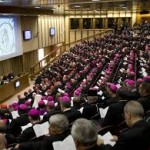by Rev. Anthony Cekada
IMMEDIATELY upon his election by the March 2013, Jorge Bergoglio (“Pope Francis”) started signaling his intention to push the Vatican II revolution forward at warp speed. Where John Paul II and Benedict XVI were content to “make haste slowly” and generally willing to follow certain conventions in order to give the appearance of “continuity,” Bergoglio most certainly is not.
At nine months, how stands the Bergoglio revolution? What are some of its main themes so far?
 1. Diminish the Papacy
1. Diminish the Papacy
From the signs Francis gave during his first few days in office, Bishop Sanborn and I, based on our experience as survivors of the first post-Vatican II decade, predicted in a show on Restoration Radio the day after his election that one of his principal goals would be to diminish and undermine the traditional notion of the papacy.
And this is just what he has done, again and again, through words and symbolic gestures. He refuses to wear the traditional papal garb (mozetta, rochet and stole), rode on a bus with the cardinals, made a big to-do of personally paying his own hotel bill, abandoned the papal apartments for the Vatican hotel, tools around in a Ford or a junky Renault, removed all papal titles except “Bishop of Rome” from the main page of the papal yearbook, refused to attend a concert at which he was to have the place of honor, ostentatiously carries his own briefcase onto a plane, signs documents without employing the title “pope,” incenses “hierarchical inferiors” in a false show of humility at an episcopal consecration, refuses to wear ornate liturgical vestments, shakes hands with puzzled Swiss Guards who are trying to salute him, installs a beach ball and sweatshirt on the altar of the Baslica of S. Mary Major, wears a pectoral cross that looks like a beer can opener, dons funny hats and finally, even puts on a clown nose.
One or two of the foregoing one could perhaps dismiss as quirks. But since the customs and restrained papal persona that Bergoglio spurned were all rooted in one central idea — the dignity of the papal office due to its centrality in the life of the Church — his act of overthrowing them was necessarily a conscious and deliberate assault against the office, and of course, the dogmatic presuppositions behind it.
Diminishing the monarchical papacy goes hand in hand with his scheme to…
 2. Empower Bishops’ Synods as Engines of Revolution
2. Empower Bishops’ Synods as Engines of Revolution
As I pointed out in a July 30 post, Bergoglio’s agenda included overhauling church legislation and governance through what he called “the relationship between synodality and primacy,” portending synods of bishops (if not clergy and laity) that would be given real legislative authority.
This was the great unrealized hope for all the ecclesiastical revolutionaries of Bergoglio’s generation — that Vatican II’s teaching on the collegiality of bishops could be parlayed into an array of international and national assemblies that would democratize the Church and seize power from the “imperial papacy.”
The international synods of bishops held so far since Vatican II have been non-events at which the participants merely rubber-stamped documents churned out by the Paul VI, JP2 or B16 Curia (papal bureaucracy).
This, one can be sure will not happen under Bergoglio who has made it amply clear that he detests the Curia, wants to decentralize church decision-making, and intends to “devolve” certain prerogatives to the bishops. He has decreed an “Extraordinary International Synod” for bishops to be held in October 2014, in advance of the Ordinary Synod to be held in 2015. This two-step process, commentators say, will allow bishops to exchange proposals at the 2014 session and ratify them at the 2015 session.
While according to the 1983 Code of Canon Law, these synods do not have true legislative power, Bergoglio can change that all with the stroke of a pen, which is what I am betting he will do.
I also predict that Bergoglio will institute synods on a national level as well. JP2 clipped the wings of national bishops’ conferences. Bergoglio, on the other hand, was a major player in CELAM, the radical Latin American bishops’ conference. Indeed, he made a major policy address to the group on July 28 in Rio announcing his agenda for “synodality.”
Once legislative power is allowed to devolve to national synods, the fireworks will really begin, because the hordes of laymen now employed as full-time administrators and decision makers at the grass roots level of Novus Ordo parishes and dioceses wield enormous influence and for the most part have adopted the modernist doctrinal and moral bromides.
 3. Use Dialogue and Consultation to Undermine Moral Principles
3. Use Dialogue and Consultation to Undermine Moral Principles
Again, any ’60s survivor recognizes the revolutionary’s tactic of a call for “dialogue” or “consultation” on doctrinal or moral issues. It operates on the hidden principle that all sides in the “conversation” (another buzzword applied the same process), be they Pius XII or the Nuns on the Bus, have an equal right to have their ideas heard, and that through a happy synthesis, a new “truth” will evolve.
An important part of the revolutionary process is orchestrating popular pressure for change from below. So, as a lead up to the synod, whose theme is “Pastoral Challenges to the Family in the Context of Evangelization,” the Vatican circulated a set of 38 questions to clergy and laity, soliciting opinions on “same-sex marriage,” divorce/remarriage and contraception.
Gee, what do you think that nominal Catholics — who have not been taught the essentials of Catholic doctrine or morality for fifty years, who live in a sex-drenched culture, who pop birth control pills like M&Ms, whose suburban parishes are run patriarchy-hating female commissars, who believe that everyone “means well,” whose pope has told them not “obsess” or “judge” — what do you think their answers to the questionnaire will be?
And then what will we be told? That their ideas are the voice of the People of God in whom the Holy Spirit works, thanks to the priesthood of their baptism, and it calls us to re-examine the harsh ideologies of the past in light of the new, merciful outlook of our beloved Holy Father Francis.
Modernists of the National Catholic Reporter stripe, who are battle-hardened ’60s dialogue warriors, are smacking their lips over the possibilities.
 4. Undermine the Certitude of the Magisterium’s Teachings
4. Undermine the Certitude of the Magisterium’s Teachings
This, I pointed out in 9/11 for the Magisterium: The Francis Interviews, has been the aggregate effect of a whole array of Bergoglio’s statements in sermons, interviews and public discourses.
No Catholic God, no doctrinal security, denouncing “disjointed” moral teachings, asserting that spiritual interference in personal life is impossible, who am I to judge, etc. — by these and similar pronouncements Bergoglio conveys a very simple message: The magisterium of the Church can no longer deliver certitude about what to believe or how to act.
The “left” in the Conciliar Church gets the message. Remarks like these from Bergoglio “will be quoted for a long time to come,” said Richard Rohr, and are now “a part of the authoritative data.”
The President of Italy also gets it, telling Francis publicly, “Thank you for having impressed us for the absence of any dogmatism, by leaving room for doubt.”
And the effects? Merely citing the headline of one recent article will suffice: “As Illinois house approves gay marriage, Speaker Cites Pope Francis.” The Speaker, who identifies himself as a Catholic, “used the pope’s words to articulate his own reasons for supporting the bill.”
Expect more of this, lots more.
 5. Throw the Occasional Bone to “the Right”
5. Throw the Occasional Bone to “the Right”
While the left understands the signals and the ecclesiastical revolution picks up speed, it is only prudent to throw an occasional bone to the dispirited conservatives.
So, Bergoglio utters the vague assertion that he’s a “faithful son of the Church” when it comes to moral teachings, Cardinal Muller writes a letter supposedly defending traditional discipline on sacraments to the divorced and remarried, Bergoglio’s incriminating interview with Scalfari disappears from the Vatican web site, “hasty, bureaucratic judgements” on annulments are criticized, “concerns” about Bergoglio’s supposed fear of being “misunderstood” are circulated, the Fraternity of St. Peter is offered anemic praise for catering to people’s “sensibility” towards the traditional Latin Mass, and Francis puts out a letter praising a writer who advocates “the hermeneutic of reform in continuity” (conservative reading) for Vatican II.
And the freshest bone: As reported by the Rorate Caeli blog, Bergoglio phoned the Italian traditionalist writer Mario Palmaro, who had been summarily fired by an Italian Catholic radio station after writing an article criticizing Bergoglio and who is now gravely ill.
Bergolio offered Palmaro his sympathies, and added how “important” it had been for him to receive Palmaro’s criticisms.
Talk about a two-fer! First, a bone to the traditionalists — AND you get to diminish the papacy by saying criticisms of it are “important”!
These gestures cost revolutionaries like Bergoglio nothing. Since the process they follow is fuelled by dialogue between opposing ideas from which new “truths” will evolve, a few retro ideas merely season the mix.
Though some conservative apologists hype the rare traditional-sounding pronouncement (“This is huge!” Fr. Zuhlsdorf said of the “continuity” letter), their enthusiasm has a hollow and pro forma ring to it.
 6. Bless Divorce by Raising the Bar for Matrimonial Consent
6. Bless Divorce by Raising the Bar for Matrimonial Consent
In his July interview on the plane back from Brazil, Bergoglio spoke at some length on the issue of giving sacraments to the divorced and remarried. A recent book by Paul Vallely reports that Bergoglio in fact did so when he was Archbishop of Buenos Aires. He has this idea on the brain, and it will be one of the main discussion topics for the forthcoming synods.
Catholic teaching has always been clear and is based on divine law: “Whom God hath joined together let no man put asunder.” Accordingly, a Catholic who marries in the Church, divorces and then marries someone else cannot receive absolution in confession or Holy Communion. The reason is simple: the first marriage still exists, so the party who ignores this and remarries commits adultery.
Bergoglio’s July interview shows how he will try to get around this.
The Church is taking a very close look at pastoral initiatives for marriage. My predecessor in Buenos Aires, Cardinal Quarracino always used to say: ‘I consider half of today’s marriages to be invalid because people get married without realizing it means forever. They do it out of social convenience, etc…’ The issue of invalidity needs to be looked into as well.”
More tantalizing hints were offered recently by Cardinal Sean O’Malley of Boston, a member of Bergoglio’s eight-man advisory council:
The Holy Father “wants us to find ways to help people in second marriages to return to the sacraments and be reconciled, and to see if the annulment process can be more user-friendly.”
Adultery-friendly is probably more like it.
I think the path that Bergoglio will take to permit sacraments for the divorced and remarried will be to redefine the criteria required for true matrimonial consent. If you make the bar sufficiently high for (1) what a person contracting marriage is supposed to know and understand about the sacrament, and (2) the act of the will he is supposed to make, you can annul just about any Catholic marriage.
There have been other hints of this subsequently, and issue will be something to watch for in the lead up to next year’s synod.
* * *
ALL THIS points to one conclusion: Our initial reading of Bergoglio was correct. He is intent on playing catch up for the ’60s ideals and implementing at every level the Vatican II revolution.
———————————————
Order your 2014 All Saints Calendar!
For info, click here
or
Donate to our apostolate at St. Gertrude the Great here!
One Trackback/Pingback
[…] Nine months on, Fr. Anthony Cekada provides six issues of consideration that should provide points for meditation for Novus Ordo Catholics as we head towards the end of the Liturgical Year and the beginning of the calendar year. Take a read and pass it on to an open-minded friend of good will. […]